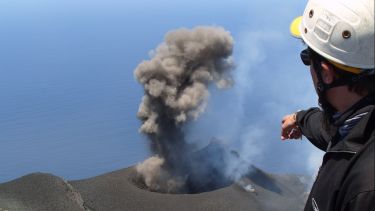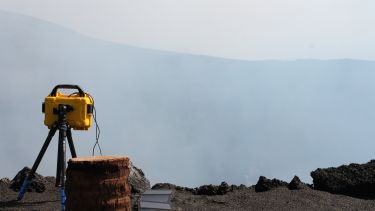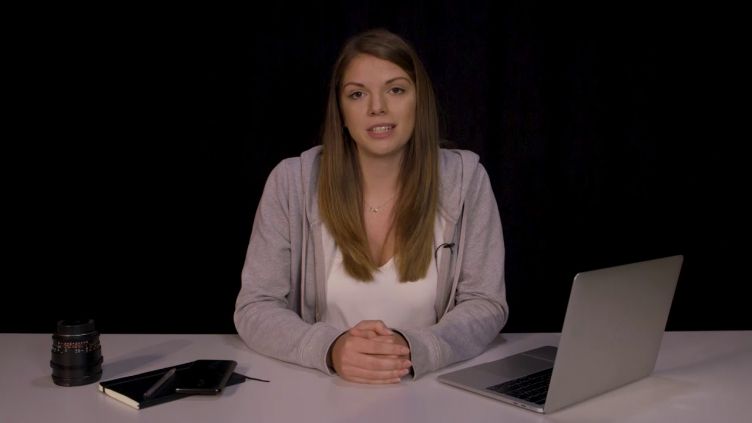The smartphone tech saving lives from the top of the world’s deadliest volcanoes
By adapting the same technology in your smartphone, researchers at the University of Sheffield have created a cost-saving alternative to high-tech remote sensing cameras used to predict volcanic eruptions.

At any given moment there are 40-60 volcanoes erupting around the world. Volcanoes host magmas with temperatures of over 700 degrees — that’s over four times hotter than any known organism can survive. Whether they’re in Italy, Peru or elsewhere in the world volcanoes can be a dangerous environment, and nobody wants to be too close when they erupt. But that hasn’t stopped Tom and Andrew from spending nearly a whole month of the year on the edge of some of the most dangerous environments on earth measuring the gas they release.
Dr Andrew McGonigle and Dr Tom Pering are both lecturers in volcanology at the University of Sheffield and avid volcanologists. It’s not a glamorous job, sat by an open mouth in the Earth’s crust for hours on end, watching as the volcano exhales sulphurous gases. Despite this, it needs to be done to help predict volcanic activity and protect the communities living in the vicinity of these volatile expressions of nature. However, thanks to smartphone technology they’re doing it for a fraction of its usual cost.
Volcanic eruptions can be devastating. Lava flows destroy anything and everything in their path, sweeping entire communities out of their homes and away from their livelihoods. “There are a lot of hazards that can occur during or after a volcanic eruption. There’s ashfall, fast moving currents of hot gas and volcanic matter known as pyroclastic flows and destructive mudflows called lahars. These can have a disastrous impact on a local scale through direct fatalities, but they also have a global impact, for example they can affect global climate,” explains Andrew.
There are various measures that, when combined, can help reduce the costs of volcanic eruptions. “Seismometers measure ground tremors that occur before and during an eruption and then there are cameras which monitor the changes in volcanic gases that happen before an eruption,” says Tom. But a lot of this technology is expensive, with gas monitoring cameras averaging £30,000. And many of the world’s volcanoes are located in areas of the world where GDP is too low to afford expensive volcano monitoring technology — no matter how life-saving.
Those heavy price tags also put the technology out of reach of Andrew and Tom.
We needed a way of measuring gas emissions from volcanoes really rapidly, roughly once every few seconds.
Professor Andrew McGonigle
The University of Sheffield Department of Geography
“We needed a way of measuring gas emissions from volcanoes really rapidly, roughly once every few seconds,” says Andrew. He describes this as ‘seeing the volcano breathing’. The idea is that it’ll give far more insights than current methods which measure with much less regularity. So how does this help predict a volcanic eruption? Various gases pouring from a volcano’s open mouth absorb light in the ultraviolet spectrum. This causes the image seen by the camera to appear darker where the gas is present. In the run up to an eruption the quantity of gases coming from the volcano shifts and detecting this can be a useful tool in forecasting an eruption.
With necessity as the mother of invention, Tom, Andrew and their team set about creating their own camera to monitor the gas coming out of the volcano. To do this they adapted the same technology found in their smartphones. “Most smartphone technology has a specific coating which stops ultraviolet (UV) light being registered by the camera sensor. We removed this so the sensors could then measure UV light. We can then adapt this using filters so that only the UV light we’re interested in can get to the camera sensor,” explains Tom. By coupling this with Raspberry Pi technology and 3D printed parts the team were able to build a gas-sensing camera for roughly £500 - a fraction of the cost of the ones on the market.
“We’ve got collaborators in multiple countries, from Italy to Chile using our technology to monitor volcanoes and forecast eruptions which will save lives. And because the cameras are low cost and capable of measuring ultraviolet light they can be used for far more than just volcano remote sensing. They could be used in point-of-care medical procedures or for measuring the reflective properties of rocks,” says Andrew.
Without advancements in smartphone technology and the technology industry in general it wouldn't have been possible to build this affordable, life-saving piece of kit. But these advancements would be useless if it wasn’t for people like Andrew and Tom, using their knowledge to develop it and impact on the wider world.
By Alicia Shephard, Research Marketing and Content Coordinator
Further information
Professor Andrew McGonigle, the University of Sheffield
Dr Tom Pering, the University of Sheffield
Research publications
The PiSpec: A low-cost, 3D-printed spectrometer for measuring volcanic SO2 emission rates
Measuring and Visualizing Solar UV for a Wide Range of Atmospheric Conditions on Hawai’i Island
Ultraviolet Imaging of Volcanic Plumes: A New Paradigm in Volcanology
Read more
For further information contact:
Sophie Armour
Media Relations Officer
University of Sheffield
0114 222 3687
sophie.armour@sheffield.ac.uk



